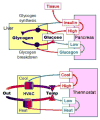Engineering control into medicine
- PMID: 25680579
- PMCID: PMC4414787
- DOI: 10.1016/j.jcrc.2015.01.019
Engineering control into medicine
Abstract
The human body is a tightly controlled engineering miracle. However, medical training generally does not cover "control" (in the engineering sense) in physiology, pathophysiology, and therapeutics. A better understanding of how evolved controls maintain normal homeostasis is critical for understanding the failure mode of controlled systems, that is, disease. We believe that teaching and research must incorporate an understanding of the control systems in physiology and take advantage of the quantitative tools used by engineering to understand complex systems. Control systems are ubiquitous in physiology, although often unrecognized. Here we provide selected examples of the role of control in physiology (heart rate variability, immunity), pathophysiology (inflammation in sepsis), and therapeutic devices (diabetes and the artificial pancreas). We also present a high-level background to the concept of robustly controlled systems and examples of clinical insights using the controls framework.
Keywords: Artificial pancreas; Autoimmune disease; Control systems; Heart rate variability; Sepsis.
Copyright © 2014 Elsevier Inc. All rights reserved.
Conflict of interest statement
Figures





References
-
- Csete ME, Doyle JC. Reverse engineering of biological complexity. Science. 2002;295:1664–9. - PubMed
-
- Chandra FA, Buzi G, Doyle JC. Glycolytic oscillations and limits on robust efficiency. Science. 2011;333(6039):187–192. - PubMed
-
- [Last Accessed 29 October 2014];HeRO®. http://www.heroscore.com/
Publication types
MeSH terms
Grants and funding
LinkOut - more resources
Full Text Sources
Other Literature Sources
Medical

